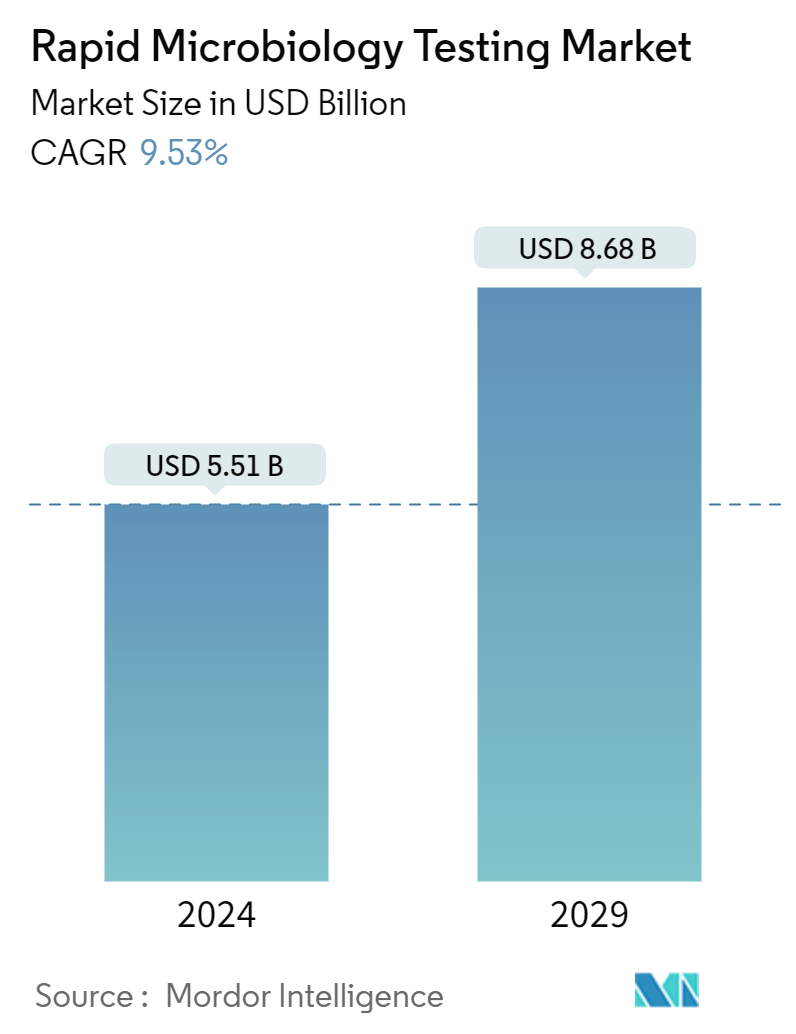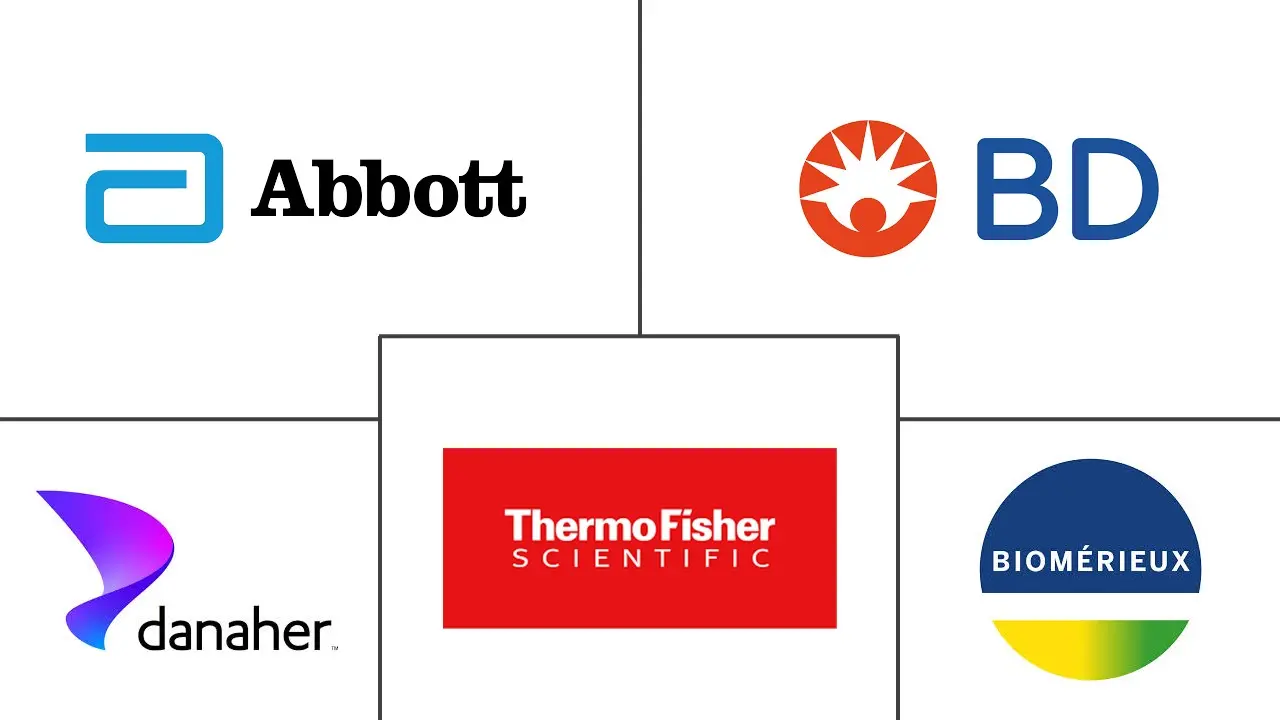Market Size of Rapid Microbiology Testing Industry

| Study Period | 2019 - 2029 |
| Market Size (2024) | USD 5.51 Billion |
| Market Size (2029) | USD 8.68 Billion |
| CAGR (2024 - 2029) | 9.53 % |
| Fastest Growing Market | Asia Pacific |
| Largest Market | North America |
Major Players
*Disclaimer: Major Players sorted in no particular order |
Rapid Microbiology Testing Market Analysis
The Rapid Microbiology Testing Market size is estimated at USD 5.51 billion in 2024, and is expected to reach USD 8.68 billion by 2029, growing at a CAGR of 9.53% during the forecast period (2024-2029).
Rapid microbiology testing is the near-real-time or real-time analysis of microbial presence in a sample without incubation, intervention, or laboratory services. With rapid urbanization, water pollution has become increasingly severe, causing several diseases, such as dysentery and enteritis, and is particularly prominent in developing nations. Hence, routine surveillance of pathogens in water is essential for public health, especially the water utilized in the food and beverage and pharmaceutical sectors. For instance, the CDC’s March 2024 estimates showcased that Salmonella bacteria cause about 1.35 million infections and 26,500 hospitalizations annually in the United States. However, the current detection methods are slow and lack accuracy, which makes it difficult to prevent and control water-borne diseases. It, thus, necessitates the requirement for rapid microbiology testing.
Additionally, the rising consumption of packaged food globally is boosting the growth of the food and beverage industry. This, in turn, is prompting the requirement for stringent inspection for any food-borne diseases. For instance, in February 2024, Modesto-based Rizo Lopez Foods Inc. recalled all packaged goods produced in the month due to potential contamination with listeriosis causing Listeria monocytogenes. Again, data published in May 2023 by Food Standards Australia New Zealand (FSANZ) showcased that a significant portion of packaged food recalls in Australia and New Zealand were related to microbial contamination and foreign matter. Such incidents necessitate the application of rapid methods of microbial analysis to deliver the critical information needed to maintain control of the production process across different industry verticals.
Furthermore, at present, the detection of pathogenic bacteria in food and water is mainly based on selective culture and standard biochemical methods. With a persistent rise in infectious diseases worldwide, the demand for rapid and precise testing kits is rising, promoting the market's growth and leading to the development of advanced testing kits. For instance, in February 2024, Nemis Technologies AG unveiled the N-Light Salmonella Risk Indicator Test, an advanced real-world environmental monitoring kit for food processing facilities. Such developments of advanced kits aid in the broader usage of rapid test kits in food manufacturing facilities.
Moreover, the rising research of rapid microbial testing in containing and managing large-scale infectious diseases is also anticipated to drive the market's growth. For instance, in September 2023, scientists at the University of Surrey developed Electro-chemical LAMP (eLAMP), an affordable new molecular test for bacteria and viruses, including SARS-CoV-2. The development of the product was aimed at easily containing any future pandemic-like situations, as encountered during the COVID-19 pandemic.
Thus, the rising availability and the growing demand for rapid microbiology testing from the food and beverage industry are expected to drive the market’s growth. However, industrial applications of rapid microbiology testing require a substantial upfront investment since most instruments and testing kits utilized for rapid microbiology testing have relatively higher prices. Such factors act as a restraint for the market.
Rapid Microbiology Testing Industry Segmentation
Rapid microbiology testing refers to the near-real-time analysis of a sample to determine the presence of a microbe of interest. Different companies have launched advanced kits to obtain accurate results through rapid microbiology testing.
The rapid microbiology testing market is segmented into product type, method, end-user, and geography. The market is segmented by product type into consumables, instruments, and reagents and kits. The instruments segment is further segmented into automated identification and testing systems, bioluminescence and fluorescence-based detection systems, mass spectrometers, and other instruments. The market is segmented by method into cellular component-based testing, nucleic acid-based testing, and other methods. Based on end user, the market is segmented into clinical laboratories, food and beverage industry, healthcare facilities, life science research and development facilities, and other end users. By geography, the market is segmented into North America, Europe, Asia-Pacific, Middle East and Africa, and South America. The report also offers the market size and forecasts for 17 countries across the region. For each segment, the market sizing and forecasts were made on the basis of value (USD).
| By Product Type | ||||||
| Consumables | ||||||
| ||||||
| Reagents and Kits |
| By Method | |
| Cellular Component-based Testing | |
| Nucleic Acid-based Testing | |
| Other Methods |
| By End User | |
| Clinical Laboratories | |
| Food and Beverage Industry | |
| Healthcare Facilities | |
| Life Science Research and Development Facilities | |
| Other End Users |
| By Geography | ||||||||
| ||||||||
| ||||||||
| ||||||||
| ||||||||
|
Rapid Microbiology Testing Market Size Summary
The rapid microbiology testing market is poised for significant growth, driven by the increasing need for near-real-time analysis of microbial presence in various sectors, including food and beverage, pharmaceuticals, and public health. This market is characterized by the demand for advanced testing kits that can quickly and accurately detect pathogens, addressing challenges such as water pollution and foodborne diseases. The rising consumption of packaged foods and the necessity for stringent quality control measures are further propelling the market. Innovations in testing technologies, such as the development of advanced kits and devices, are enhancing the efficiency and accuracy of microbial testing, thereby supporting market expansion. However, the high upfront costs associated with these advanced instruments pose a challenge, potentially restraining market growth.
North America is expected to lead the rapid microbiology testing market, supported by its well-established healthcare infrastructure, regulatory frameworks, and the presence of key industry players. The region's focus on advanced technologies and government initiatives to promote rapid testing methods are contributing to market growth. The demand for rapid testing kits is also driven by the need for early detection of diseases, such as HIV, and the increasing prevalence of infectious diseases. Collaborative efforts and strategic partnerships among prominent companies and research institutions are fostering innovation and adoption of rapid testing solutions. The market's competitive landscape is moderately consolidated, with major players like Abbott Laboratories, Becton, Dickinson & Company, and Thermo Fisher Scientific holding significant market shares and actively engaging in research and development to enhance testing capabilities.
Rapid Microbiology Testing Market Size - Table of Contents
-
1. MARKET DYNAMICS
-
1.1 Market Overview
-
1.2 Market Drivers
-
1.2.1 Rising Number of Infectious Diseases
-
1.2.2 Increasing Adoption by Food and Beverage Industry
-
1.2.3 Growing Government Initiatives
-
-
1.3 Market Restraints
-
1.3.1 High Initial Investment in Instruments
-
-
1.4 Porter's Five Forces Analysis
-
1.4.1 Threat of New Entrants
-
1.4.2 Bargaining Power of Buyers/Consumers
-
1.4.3 Bargaining Power of Suppliers
-
1.4.4 Threat of Substitute Products
-
1.4.5 Intensity of Competitive Rivalry
-
-
-
2. MARKET SEGMENTATION (Market Size by Value - USD)
-
2.1 By Product Type
-
2.1.1 Consumables
-
2.1.2 Instruments
-
2.1.2.1 Automated Identification and Testing Systems
-
2.1.2.2 Bioluminescence and Fluorescence-based Detection Systems
-
2.1.2.3 Mass Spectrometers
-
2.1.2.4 Other Product Types
-
-
2.1.3 Reagents and Kits
-
-
2.2 By Method
-
2.2.1 Cellular Component-based Testing
-
2.2.2 Nucleic Acid-based Testing
-
2.2.3 Other Methods
-
-
2.3 By End User
-
2.3.1 Clinical Laboratories
-
2.3.2 Food and Beverage Industry
-
2.3.3 Healthcare Facilities
-
2.3.4 Life Science Research and Development Facilities
-
2.3.5 Other End Users
-
-
2.4 By Geography
-
2.4.1 North America
-
2.4.1.1 United States
-
2.4.1.2 Canada
-
2.4.1.3 Mexico
-
-
2.4.2 Europe
-
2.4.2.1 Germany
-
2.4.2.2 United Kingdom
-
2.4.2.3 France
-
2.4.2.4 Italy
-
2.4.2.5 Spain
-
2.4.2.6 Rest of Europe
-
-
2.4.3 Asia-Pacific
-
2.4.3.1 China
-
2.4.3.2 Japan
-
2.4.3.3 India
-
2.4.3.4 Australia
-
2.4.3.5 South Korea
-
2.4.3.6 Rest of Asia-Pacific
-
-
2.4.4 Middle East and Africa
-
2.4.4.1 GCC
-
2.4.4.2 South Africa
-
2.4.4.3 Rest of Middle East and Africa
-
-
2.4.5 South America
-
2.4.5.1 Brazil
-
2.4.5.2 Argentina
-
2.4.5.3 Rest of South America
-
-
-
Rapid Microbiology Testing Market Size FAQs
How big is the Rapid Microbiology Testing Market?
The Rapid Microbiology Testing Market size is expected to reach USD 5.51 billion in 2024 and grow at a CAGR of 9.53% to reach USD 8.68 billion by 2029.
What is the current Rapid Microbiology Testing Market size?
In 2024, the Rapid Microbiology Testing Market size is expected to reach USD 5.51 billion.

